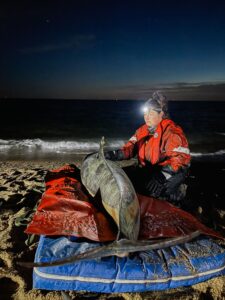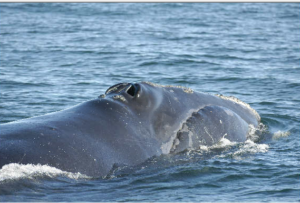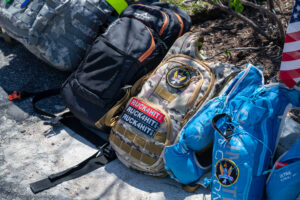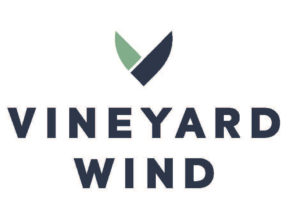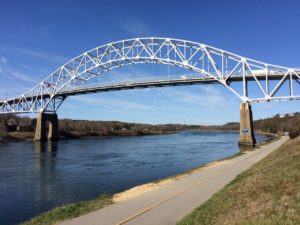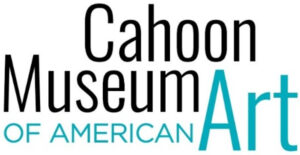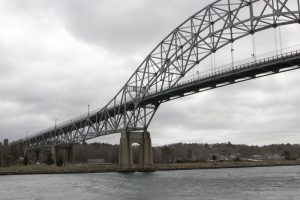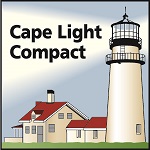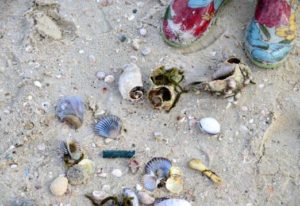 BUZZARD BAY – Every day, waves, wind, and the ceaseless cycle of the tides touch more than 200 miles of shoreline around Buzzards Bay. As the water comes and goes, it leaves behind an incredible variety of objects from the sea. For beachcombers, the Bay’s combination of exposed shores and protected coves offer a banquet to explore.
BUZZARD BAY – Every day, waves, wind, and the ceaseless cycle of the tides touch more than 200 miles of shoreline around Buzzards Bay. As the water comes and goes, it leaves behind an incredible variety of objects from the sea. For beachcombers, the Bay’s combination of exposed shores and protected coves offer a banquet to explore.
The best time to comb the beach is usually after a stormy or windy day, when large waves lift heavier items and wash up objects from deeper waters. You’ll find some of the best treasures in the “wrack line”: the thick ribbon of seaweed, shells, and debris that forms on beaches at the high tide line.
Although beachcombing is a four-season activity, winter can actually be the best time to take a beach walk: winter storms often bring some of the best finds ashore, and fewer crowds mean you have a better chance of finding a treasure.
Here are 14 of the most common shells and objects you might find when you go beachcombing – and a list of Buzzards Bay beaches to get you started on your adventure.
What shells and objects can I find on Buzzards Bay’s beaches?
From clams to scallops to egg cases, Buzzards Bay’s beaches offer a treasure trove of fascinating objects to find. These 14 are just a few of the dozens of species you might discover between the wrack line and the waves. For more, pick up a good beachcombing field guide as a reference.
There’s another thing you’ll probably find when you go beachcombing: trash, particularly plastic. If you want to help keep the Bay’s beaches clean, bring a disposable bag with you on your walk to pick up any trash you come across.
- Slipper shells
Slipper shells may be the most common shell you’ll find on our local beaches. They wash up in thick pink, purple and cream layers in many wrack lines. There’s little question where these curved, flat-bottomed shells get their name: flip one over and you’ll see a little shelf that closely resembles the opening to a slip-on shoe.
These pretty pastel shells are home to snails with a very interesting life. Slipper shells form stacks several animals high, often with their base on a rock or another shell. The bottom of the stack is always a female, and the shells above are males. If there are too many males on one female, or if the bottom female is lost, the slipper snail has a quick fix: the bottom-most male of the stack transforms from male to female, preserving the group’s ability to continue reproducing.
Where to find them: Nearly all Buzzards Bay beaches
- Quahogs
Digging for live quahogs is a fun activity for all ages.
As locals will know, “quahog” is New England’s name for hard clams. This local term comes from the clam’s Native American name, “poquauhock.” These edible clams are one of New England’s most popular shellfish, eaten raw, steamed, broiled, stuffed and baked, and in chowder— just to name a few. Whether you find them along the shore or gather them up after eating their delicious contents, quahog shells are also a lovely shell to collect; they often feature dark purples and blues on the inner layer, which made quahog shells valuable for creating the wampum beads that Native Americans used for trade. As these shells break apart in the tide, these colorful sections often wear into beautifully layered and rounded pieces.
Though no two quahog shells is alike, there is one particularly distinctive group you may find around Buzzards Bay. Quahogs that are seeded by towns and aquaculture farmers for harvest are usually of the notata strain, a natural but otherwise rare variety. These clams have distinctive streaks and zig-zags of color across their shells in shades of brown, red, and orange, making them a particularly exciting find for the beachcomber.
Where to find them:Nearly all Buzzards Bay beaches
- Oysters
Though another popular edible shellfish, the American oyster is a bit rarer around Buzzards Bay than it once was; over-harvesting and nitrogen pollution have greatly reduced their numbers. However, efforts by many local towns to seed harbors with oysters are starting to bear (delicious) fruit, and there are a growing number of places around Buzzards Bay where you can find these strange, knobbly shellfish.
When alive, oysters are usually clumped together in large “reefs,” sometimes on rocks and other hard surfaces. When their shells wash ashore, they’re distinctive for the smooth, silvery layers of material known as “mother of pearl” on their interior side, which is particularly beautiful when used in jewelry.
Where to find them: Most Buzzards Bay beaches
- Mussels
There are two types of mussel shells that you might find around Buzzards Bay. Both are teardrop-shaped and edible, but have slightly different appearances and habitats. Blue mussels have a smoother shell in dark blue, purple and black, banded with stripes of silvery mother-of-pearl, and grow in large groups on rocks and pilings in coastal waters. Ribbed mussels are a more muted brown or green color, with textured lines on their surface, and live in partially buried in sand or mud. Their favorite place to live is at the base of marsh grasses, where they happily filter detritus and plankton from the water.
Both of these mussels are very common around Buzzards Bay, but because their shells break easily, it’s a treat to find one whole and well-worn by the waves. The interior of a mussel, which fades from bright pearl at the tip to blue and purple around the edge, can be particularly beautiful to use in jewelry and decorations.
Where to find mussels: Blue mussels can be found on most shallow, salty coastlines; ribbed mussels are found in tidal salt marshes
- Scallops
Much like oysters, the shallow-water bay scallops that were previously common around Buzzards Bay have all but disappeared. This is largely due to nitrogen pollution, which clouds the water and makes it hard for eelgrass — bay scallops’ favorite habitat — to grow. While harvesting bay scallops commercially or recreationally has become difficult, there are places are Buzzards Bay where these blue-eyed beauties swim still.
Bay scallops’ ridged, fan-shaped shells come in stunning colors: black, blue, yellow, orange, pink, and cream, often with bands of different colors running across their ridges. If you’re searching outer Buzzards Bay beaches, you may also come across the shell of a sea scallop, the bay scallop’s deep-water cousin. These shells are larger and flatter, often a more uniform reddish-brown in color, and have little or no distinctive ridges.
Where to find them: Most Buzzards Bay Beaches
- Cockles
These strong, ridged shells look something like a cross between a quahog and a scallop, and form a pretty heart shape when hinged together. The two most common cockle shells found on Buzzards Bay shoreline belong to the common cockle, which has a white or cream shell with bands of tan and brown, and the “blood cockle,” also known as the blood ark or blood clam. This clam has a white shell coated with layer of hairy, greenish-black material called a periostracum. These clams get their vivid name for the bright red liquid and muscle tissue you’ll find if you open one. After tumbling in the surf for a long time, blood cockle shells often lose their layer of dark “hair,” leaving their shells pure white and quite lovely to collect.
The blood cockle is a very popular food in Asia, where it is eaten both raw and cooked. Its gory appearance has long been rather off-putting to New England diners, but some chefs are trying to introduce this abundant, but underutilized, clam to local palates.
Where to find them: Nearly all Buzzards Bay beaches
- Moon snails
Live moon snails, like this one found at Shell Point Beach in Onset, are fascinating for kids to examine.
The shell of the northern moon snail is a perennial favorite find for its spiral shape and stunning colors: these shells are often pink, cream, and orange, splashed or swirled with dark blue and purple. The carnivorous snails that live within can live as long as 15 years, and grow shells as large as 7 inches long in that time. Finding a live moon snail is often as exciting as discovering one of its shells, as these creatures are up to two or three times larger than their shell— making them a real treat for kids to hold and examine. In the summer, you may also find their “sand collars,” flexible semi-circular masses of compressed sand, which hold thousands of moon snail eggs.
Moon snails are also the reason that you may find many other shells on the beach with perfectly round holes in them, often near their hinge— perfectly placed to make into jewelry! These holes are created by moon snails, which use a long tongue-like structure called a radula, along with a potent acid, to drill into the bodies of other snails to get at their soft insides.
Where to find them: Calm, sandy bays and beaches
- Periwinkles
This snail is a small but mighty member of the marine community. They’re a common sight in tide pools, where they cluster on rocks to graze on algae and seaweed, but you’ll also see them carving lines through the sand on beaches, gathering on the pilings of piers and docks, and clinging to rocky coastlines beneath crashing waves. The smallest periwinkle shell you may find around Buzzards Bay belongs to the rough periwinkle, about the size of a blueberry; the ridged spiral at the top of its orange, yellow or brown shell forms a neat cone shape, sometimes with a pretty white tip. The smooth periwinkle is a bit larger than the rough periwinkle, and has a distinctive half-moon shell with a neat whorl that can be bright green, yellow, orange or red. (These look quite a lot like small moon snail shells.) The largest and the most abundant is the common periwinkle, which has a dark brown shell that can be as large as a grape; unfortunately, this species is invasive, and can wreak havoc on shorelines by devouring every marine plant in sight.
You may have grown up hearing that you can get common periwinkles to emerge from their shells by holding them and humming. Research suggests that there’s little proof that humming does anything special in persuading these snails to emerge — however, it remains a great activity to keep kids busy at the beach.
Where to find them: Nearly all Buzzards Bay coastlines
This tiny periwinkle or dog whelk shell, found on Onset Beach, has now become the home of a horseshoe crab.
- Dog Whelks
Dog whelks closely resemble smooth periwinkles, but they have a bumpier shell surface and longer, more pointed spire at the end of their shell. Dog whelk shells can also feature garish striped patterns in brown, chestnut, black, and pure white. These small snails prefer to stay beneath the tide line on rocky shores, where they can feast on mussels, barnacles, and periwinkles — making these little predators a good check on the invasive common periwinkle where they overlap.
Where to find them: Rocky shores
- Mermaids’ toenails
Sadly, “mermaids’ toenails” do not come from mythical fish people. Rather, these distinctive shells belong to the Anomia simplex clam. These thin, almost transparent shells come in orange, yellow, pink, gray and white, and have an iridescent mother-of-pearl shine. These shells are also known as jingle shells, as they can be strung together to make wind chimes that produce a musical clinking.
Jingle shells are often dispersed by commercial aquaculture, as they form a good surface upon which young oyster spat settles. As such, these shells can often be found in the same places where oysters are seeded by towns or in shellfish farming.
Where to find them: Most shallow water beaches; however, because these shells are fragile and may break apart in heavy surf, we recommend looking for them on places with calmer waves.
- Knobbed & Channeled Whelks
This channeled whelk, found on West Island, has a prominent operculum- the dark-colored “door” it uses to seal its shell when it gets too dry.
New England’s large whelks are often victims of mistaken identity: they’re commonly referred to as “conch,” which are actually their warm-water cousins. The whelks in our local waters belong to two different species: the channeled whelk, which has distinct ridges running up its spire; and the knobbed whelk, which instead has rounded spikes around its spire. A whole whelk is a beachcomber’s gem, as these large shells can come in magnificent shades of navy blue, pink, orange, yellow, chestnut and cream, marbled and striped like watercolor paint. These shells are a particular favorite for kids to hold up to their ears and listen to the echo of the ocean.
You might also be lucky enough to find a live whelk, especially if you’re out digging for quahogs. Whelks, too, have a taste for these delicious clams, and can sometimes be found buried in the sand in pursuit of them. Live whelks are quite active; if you find one alive, take a few minutes to appreciate its muscular foot and the fingernail-like “operculum” it uses to seal off its shell before returning it home.
Where to find them: Most Buzzards Bay beaches, as well as tidal mud flats
- Whelk egg casings
You’ve probably stumbled upon whelk egg casings — spiral strings of light-colored papery packets — dozens of times without realizing what you were looking at. Break one of these packets open and you’ll find an amazing sight: hundreds and hundreds of tiny, perfect baby whelks, their shells already formed despite being around the size of a sesame seed. Each species’ casing has a slightly different appearance: channeled whelk casings pinch together at the edges like a closed seashell, while knobbed whelk casings are flat at their edges like the side of a coin.
Break open a whelk egg casing to find thousands of tiny shells.
Whelks lay these egg casings in the winter, and will bury one end in sand or mud to prevent them from washing ashore. As such, they’re a common sight on the beach after storms.
Where to find them: Most Buzzards Bay beaches, most abundantly in the winter and early spring
- Mermaid’s Purses
Also known as “devil’s purses” due to the curling horns at each of their corners, these dark capsules are the egg cases of skates. (Those horns secure the egg case to plants and rocks while a baby skate grows inside.) Around Buzzards Bay, mermaid’s purses most likely belong to one of two skate species: the little skate or the winter skate. The little skate’s egg cases are dark brown to nearly black with one set of short horns and one set of long horns, while the winter skate’s cases are greenish brown with four very long, skinny horns.
Mermaid’s purses can be found on the beach any time of year. They’re usually empty, but occasionally you may find a living egg cases that has washed up during storms. Living egg cases are heavy and leathery; you can check by holding the case up to the sun or a flashlight and looking for something wriggling inside!
Where to find them: Exposed beaches with lots of waves
- Horseshoe Crab Molts
You’ve probably spotted the brown, helmet-like shapes of horseshoe crabs scattered on the sand of local beaches in late summer and early fall. Often, these aren’t dead crabs — but rather old shells that horseshoe crabs molt and discard as they grow. If you happen to find a fresh molt that hasn’t yet dried and hardened, you should be able to peel open the front section, below the eyes, and look into the space where the crab used to live.
Horseshoe crab molts can make great decorations, especially since they look so life-like. Just be sure to dry the molt thoroughly in the sun to ensure that this shell doesn’t bring any odd smells from the beach into your home!
Where to find them: Sandy, protected beaches
Where can I go beachcombing on Buzzards Bay?
Nearly all of Buzzards Bay’s beaches offer great beachcombing adventures. Here are a few ideas to get you started!
Easy beachcombing spots for families
Little Harbor Beach in Wareham offers a sheltered shoreline that’s easy for kids to explore.
Beachcoming is a fantastic activity for kids and families. If you want to go to a beach that offers great beachcombing in a small area, check out these places:
- Goosewing Beach Preserve(Little Compton)
- Gooseberry Island(Westport)
- Apponagansett Park(Dartmouth)
- Fort Taber Park(New Bedford)
- West Island Town Beach(Fairhaven)
- Fort Phoenix State Reservation(New Bedford)
- Shining Tides Beach(Mattapoisett)
- Planting Island Beach(Marion)
- Shell Point Beach(Wareham)
- Squeteague Harbor Beach(Bourne)
- Wood Neck Beach(Falmouth)
Beaches with a walk
The rocky, wave-exposed shores of Gooseberry Island can hold interesting treasures tossed up by outer Buzzards Bay.
Long walks on the beach aren’t just for romance – they offer the chance to linger and look for more unique objects along the shore. These beaches are excellent spots to get in a walk with your beachcombing adventure.
- Horseneck Beach State Reservation(Westport)
- Round Hill Town Beach(Dartmouth)
- Winsegansett Marshes(Fairhaven)
- West Island State Reservation(Fairhaven)
- Nasketucket Bay State Reservation(Mattapoisett)
- Munn Preserve(Mattapoisett)
- Brainard Marsh(Marion)
- Lyman Reserve(Wareham/Plymouth/Bourne)
- Lawrence Island(Bourne)
More remote beachcombing spots
Want a true beachcombing adventure? These beaches are all located on islands, which means you’ll need a watercraft of some kind to reach them. But when you get there, you’re bound to discover some amazing objects on these shores!
- Wickets Island(Wareham)
- Bassetts Island (Bourne)
- Church’s Beach(Gosnold)
- Barges Beach (Gosnold)
- Menemsha Hills(Martha’s Vineyard)
Material from www.savebuzzardsbay.org






